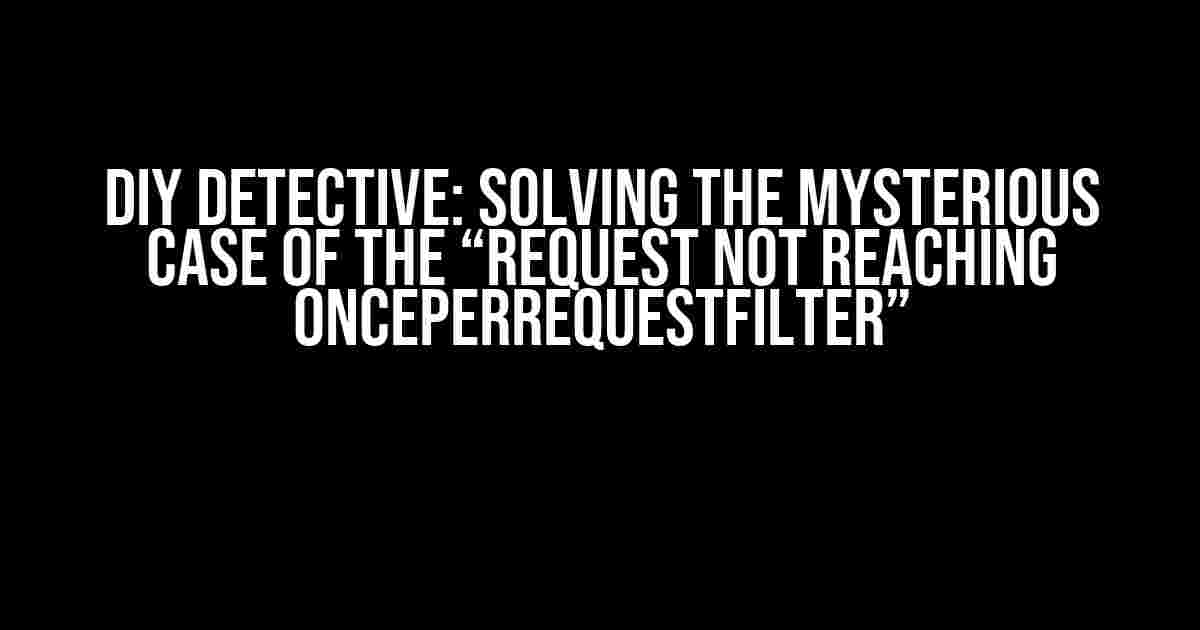Welcome, fellow developers! Have you ever found yourself scratching your head, trying to figure out why that pesky OncePerRequestFilter isn’t catching your requests? You’re not alone! In this article, we’ll embark on a thrilling adventure to uncover the reasons behind this frustrating phenomenon and provide you with practical solutions to get your filters firing on all cylinders.
The Prime Suspects: Common Culprits Causing the Issue
Before we dive into the solutions, let’s examine the usual suspects that might be hindering your OncePerRequestFilter from intercepting requests:
-
Filter Ordering
The order in which filters are registered can affect their execution. If your OncePerRequestFilter is not registered correctly, it might not be reached.
-
Incorrect Configuration
A misconfigured filter can prevent it from capturing requests. Check your web.config or filter implementation for any errors.
-
Request Routing
The routing mechanism might be bypassing your filter. Ensure that the request is being routed through the correct pipeline.
-
Middleware Interference
Other middleware components might be interfering with your filter. Identify any potential conflicts and address them.
Investigation and Debugging Techniques
Now that we’ve identified the prime suspects, let’s get to the bottom of the issue using some tried-and-true debugging techniques:
-
Enable Debug Logging
Configure your application to output debug logs, which will help you trace the request pipeline and identify any issues.
System.Diagnostics.Trace.Listeners.Add(new System.Diagnostics.TextWriterTraceListener("debug.log")); -
Use Breakpoints and Debuggers
Set breakpoints in your filter implementation and debug the application to step through the code and inspect variables.
public class MyFilter : IAsyncResourceFilter { public async Task OnResourceExecutionAsync/resourceExecutionContext context) { // Set a breakpoint here await context.Next.OnResourceExecutionAsync(context); } } -
Verify Filter Registration
Double-check that your filter is correctly registered in the web.config or startup.cs file.
services.AddControllers(options => options.Filters.Add(new MyFilter()));
Forensic Analysis: Dissecting the Request Pipeline
Let’s dive deeper into the request pipeline to understand how filters are executed and identify potential bottlenecks:
| Stage | Description |
|---|---|
| 1. Routing | The request is routed to the correct controller and action. |
| 2. Filter Execution | Filters are executed in the order they were registered. |
| 3. Controller Execution | The controller action is executed. |
| 4. Response Generation | The response is generated and sent back to the client. |
By examining the request pipeline, you can identify where the issue is occurring and focus your debugging efforts accordingly.
Solution Strategies
Now that we’ve gathered evidence and analyzed the request pipeline, it’s time to implement solutions to get your OncePerRequestFilter working as expected:
Reorder Filters for Optimal Execution
Re-register your filters in the correct order to ensure they’re executed as intended:
services.AddControllers(options => options.Filters.Add(new MyFilter())); services.AddControllers(options => options.Filters.Add(new AnotherFilter()));
Improve Filter Configuration
Review your filter implementation and configuration to ensure it’s correct and complete:
public class MyFilter : IAsyncResourceFilter
{
public async Task OnResourceExecutionAsync(ResourceExecutionContext context)
{
// Corrected filter implementation
await context.Next.OnResourceExecutionAsync(context);
}
}
Route Requests Correctly
Verify that requests are being routed through the correct pipeline:
routes.MapRoute(name: "default", template: "{controller}/{action}/{id}", defaults: new { controller = "Home", action = "Index" });
Eliminate Middleware Interference
Identify and address any middleware conflicts that might be affecting your filter:
public void Configure(IApplicationBuilder app, IWebHostEnvironment env)
{
// Remove or reorder middleware to avoid conflicts
app.UseMiddleware();
app.UseRouting();
app.UseEndpoints(endpoints =>
{
endpoints.MapControllers();
});
}
Conclusion: Cracking the Case of the Missing Filter
By following the steps outlined in this article, you should be able to identify and resolve the issues preventing your OncePerRequestFilter from capturing requests. Remember to stay methodical, persistent, and creative in your debugging efforts. Happy detective work!
Don’t let the “Request not reaching OncePerRequestFilter” mystery get the best of you. With the right tools, techniques, and mindset, you can crack the case and ensure your filters are working as intended.
Frequently Asked Question
Get the answers to your most pressing questions about “Request not reaching OncePerRequestFilter”!
Why is my request not reaching the OncePerRequestFilter?
This could be due to the filter being disabled or not properly configured. Make sure the filter is enabled and its order is set correctly in the web.xml file. Also, check if there are any other filters that might be intercepting the request before it reaches the OncePerRequestFilter.
What are the common reasons for a request not reaching the OncePerRequestFilter?
Some common reasons include: the filter is not properly registered in the web.xml file, the filter is not enabled, the request is not going through the filter chain, or there is an exception being thrown before the filter is reached. Check your application’s logs for any errors or exceptions that might be occurring.
How do I debug a request that is not reaching the OncePerRequestFilter?
You can use a tool like Chrome DevTools or Fiddler to inspect the request and response headers to see if the filter is being invoked. You can also enable debug logging in your application to see the filter’s output. Additionally, check the application’s logs for any errors or exceptions that might be occurring.
Can I use multiple OncePerRequestFilters in my application?
Yes, you can use multiple OncePerRequestFilters in your application, but make sure they are properly configured and ordered in the web.xml file. Each filter should have a unique name and should be configured to execute in the correct order.
What is the difference between OncePerRequestFilter and a regular ServletFilter?
A OncePerRequestFilter is a special type of ServletFilter that is guaranteed to execute only once per request, whereas a regular ServletFilter can execute multiple times per request. This makes OncePerRequestFilter useful for tasks that need to be performed only once, such as setting up a security context or logging request information.
